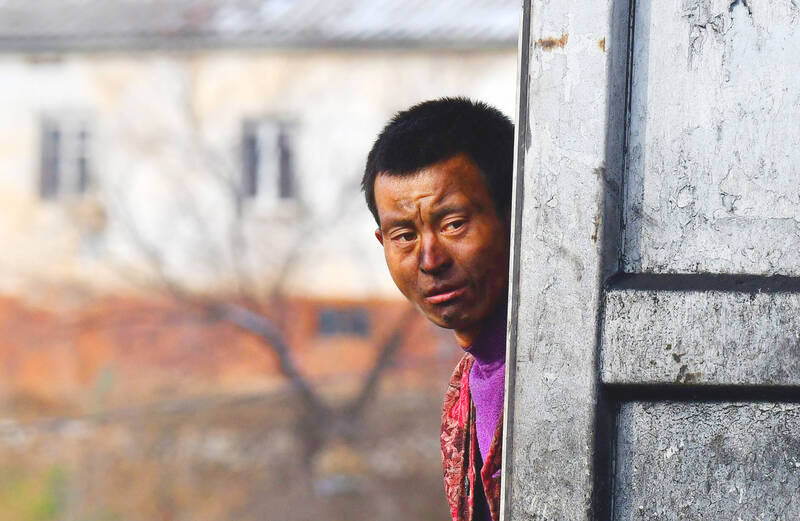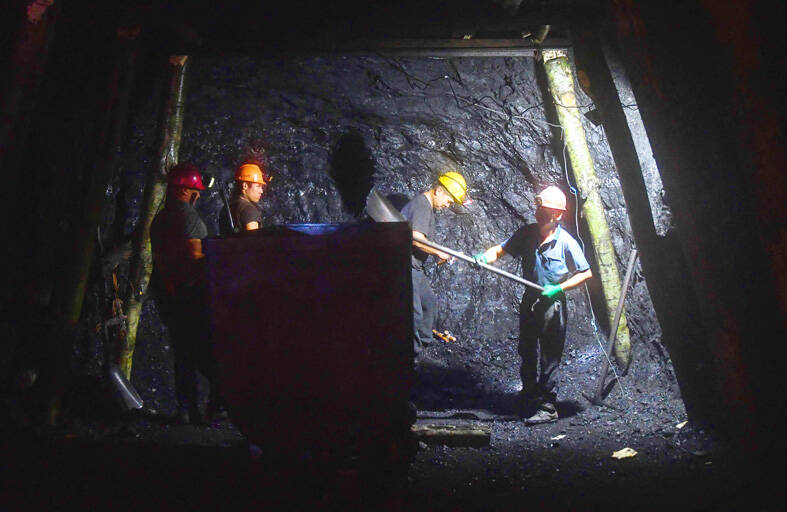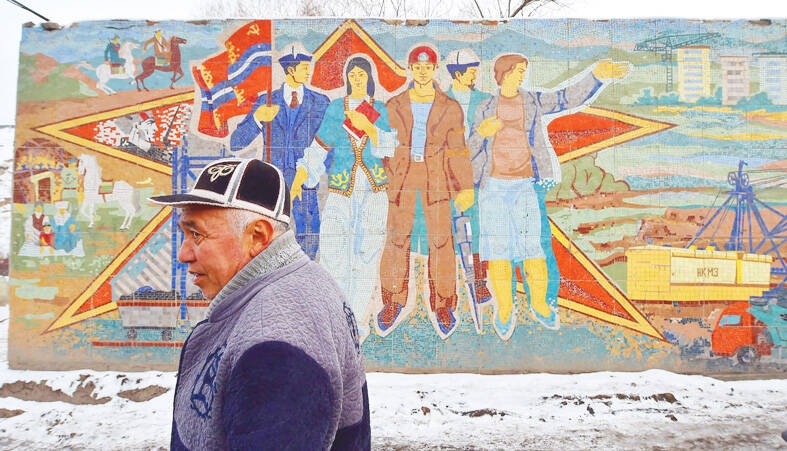Hundreds of meters underground, Emylbek Umarov hacked out lumps of coal by hand with a pickaxe in a dank mine in a remote mountainous corner of Kyrgyzstan.
Coal might be falling out of favor elsewhere because of climate change, but Suluktu’s mines hope growing demand from neighboring Central Asian countries and beyond would help them return to their Soviet heyday.
For some, like Umarov, the mine is one of the few places offering work — despite the threat of accidents that have killed dozens of people in the area in the past few years.

Photo: AFP
“It’s terrifying, it’s tough, but there’s no other work here,” said the 27-year-old, who has two degrees in computing and economics.
As he spoke, the coughing of miners with blackened faces echoed through the tunnels illuminated by a few lamps hanging from a ceiling dripping with water.
The men work with jackhammers, pickaxes and explosives on 12-hour shifts day or night 15 days a month for a monthly salary of less than 150 euros (US$159).

Photo: AFP
Before starting their shifts, they have to travel an hour to the mine in large Russian-made Kamaz trucks along a badly rutted road.
The hulks of Soviet-era machinery could be seen in the pinkish dawn.
Tucked away in the mountains, the town of Suluktu was founded in 1868 and is one of the oldest coal extraction hubs in Central Asia.

Photo: AFP
From the “miner’s bread” on sale in local bakeries to the local soccer team called “Shakhtar” (Miner) — everything in the town is a reminder of its main industry, including the coal dust coating the ground.
The town “heated Central Asia during Soviet times,” Suluktu Mayor Maksat Kadyrkulov said.
Like settlements across the former Soviet Union, it suffered from deindustrialization after its collapse, leading to a sharp drop in population and coal output.
“There is no farmland here. We just dig coal and there is no family without a miner,” Kadyrkulov said.
The mayor said he hoped Suluktu would recover its “past glory” thanks to growing demand for coal.
The Soviet era is a constant presence in the town.
On its outskirts stands a monument depicting two miners with a 4m-high hammer and sickle.
Trucks filled with coal file past the statues on their way to deliver their cargo to Uzbekistan and beyond since access to nearby Tajikistan is now closed off because of a flare-up of tensions along the border.
A mosaic nearby extols the glory of Soviet power, showing a miner with a red star behind him.
Before “we were proud to be miners,” said 64-year-old Nimadjan Abdulayevich, who spent 37 years in the mines, his voice hoarse from throat cancer.
While there have been no fatal accidents in the mine where Umarov works, the risk is constant.
“The mine is like a second front. You risk dying there,” is a phrase that miners often repeat.
Last year, the metal bars holding up the vein where Umarov was working collapsed, breaking his leg.
“Since then, the fear remains,” he said.
His father Dzhumbai, who now works on the surface as a welder, was caught up in a similar accident.
Mine director Kanynbek Ismailov said he lacked the resources for new equipment, even though the conditions in the mine are among the best of the 40 or so in Suluktu.
“We do everything by hand. We do not have new equipment,” Ismailov said.

PATENTS: MediaTek Inc said it would not comment on ongoing legal cases, but does not expect the legal action by Huawei to affect its business operations Smartphone integrated chips designer MediaTek Inc (聯發科) on Friday said that a lawsuit filed by Chinese smartphone brand Huawei Technologies Co (華為) over alleged patent infringements would have little impact on its operations. In an announcement posted on the Taiwan Stock Exchange, MediaTek said that it would not comment on an ongoing legal case. However, the company said that Huawei’s legal action would have little impact on its operations. MediaTek’s statement came after China-based PRIP Research said on Thursday that Huawei filed a lawsuit with a Chinese district court claiming that MediaTek infringed on its patents. The infringement mentioned in the lawsuit likely involved

Taipei is today suspending work, classes and its US$2.4 trillion stock market as Typhoon Gaemi approaches Taiwan with strong winds and heavy rain. The nation is not conducting securities, currency or fixed income trading, statements from its stock and currency exchanges said. Authorities had yesterday issued a warning that the storm could affect people on land and canceled some ship crossings and domestic flights. Taiwan Semiconductor Manufacturing Co (TSMC, 台積電) expects its local chipmaking fabs to maintain normal production, the company said in an e-mailed statement. The main chipmaker for Apple Inc and Nvidia Corp said it has activated routine typhoon alert

GROWTH: TSMC increased its projected revenue growth for this year to more than 25 percent, citing stronger-than-expected demand for AI devices and smartphones The Taiwan Institute of Economic Research (TIER, 台灣經濟研究院) yesterday raised its forecast for Taiwan’s GDP growth this year from 3.29 percent to 3.85 percent, as exports and private investment recovered faster than it predicted three months ago. The Taipei-based think tank also expects that Taiwan would see a 8.19 percent increase in exports this year, better than the 7.55 percent it projected in April, as US technology giants spent more money on artificial intelligence (AI) infrastructure and development. “There will be more AI servers going forward, but it remains to be seen if the momentum would extend to personal computers, smartphones and

Catastrophic computer outages caused by a software update from one company have once again exposed the dangers of global technological dependence on a handful of players, experts said on Friday. A flawed update sent out by the little-known security firm CrowdStrike Holdings Inc brought airlines, TV stations and myriad other aspects of daily life to a standstill. The outages affected companies or individuals that use CrowdStrike on the Microsoft Inc’s Windows platform. When they applied the update, the incompatible software crashed computers into a frozen state known as the “blue screen of death.” “Today CrowdStrike has become a household name, but not in